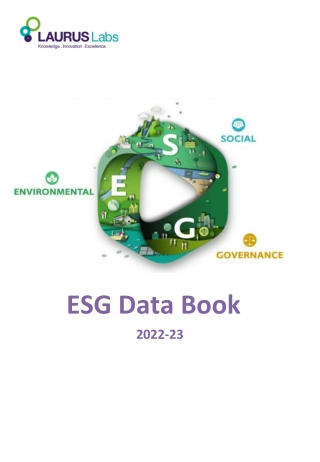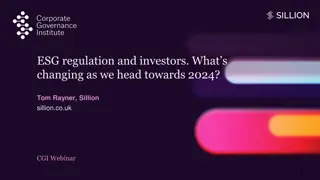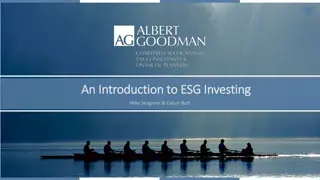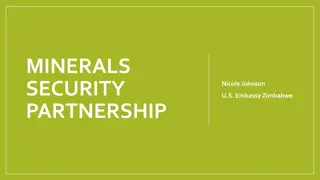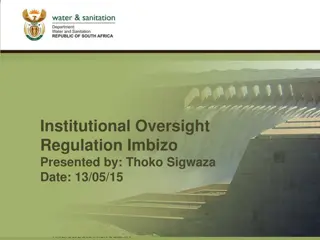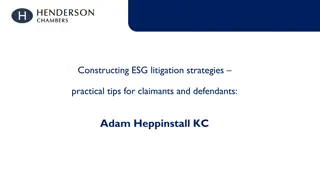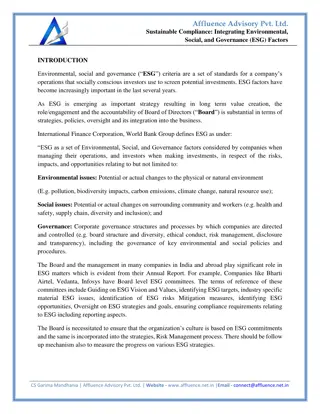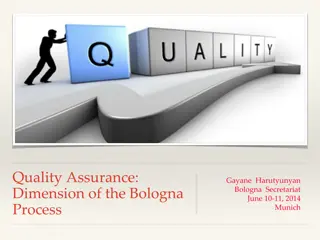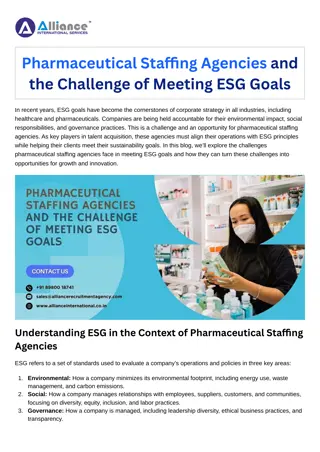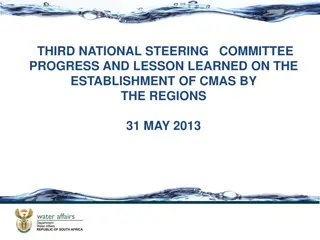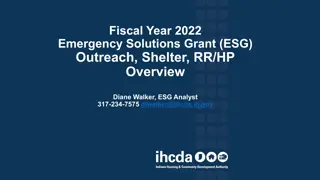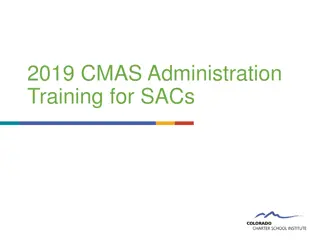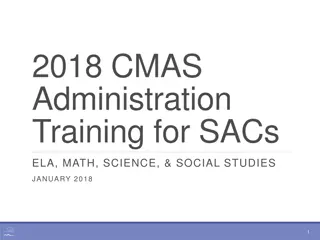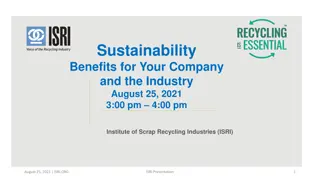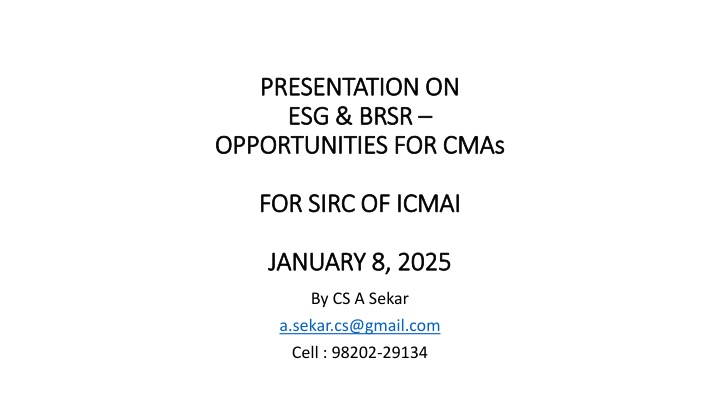
Opportunities in ESG & BRSR for CMAs - SIRC of ICMAI
Scope & concerns of ESG encompassing environmental, social, and governance aspects. Understand Triple Bottom Line accounting and its significance in sustainability concepts. Delve into the comparison of TBL, ESG, and sustainability for informed decision-making and responsible investing.
Download Presentation

Please find below an Image/Link to download the presentation.
The content on the website is provided AS IS for your information and personal use only. It may not be sold, licensed, or shared on other websites without obtaining consent from the author. If you encounter any issues during the download, it is possible that the publisher has removed the file from their server.
You are allowed to download the files provided on this website for personal or commercial use, subject to the condition that they are used lawfully. All files are the property of their respective owners.
The content on the website is provided AS IS for your information and personal use only. It may not be sold, licensed, or shared on other websites without obtaining consent from the author.
E N D
Presentation Transcript
PRESENTATION ON PRESENTATION ON ESG & BRSR ESG & BRSR OPPORTUNITIES FOR CMAs OPPORTUNITIES FOR CMAs FOR SIRC OF ICMAI FOR SIRC OF ICMAI JANUARY 8, 2025 JANUARY 8, 2025 By CS A Sekar a.sekar.cs@gmail.com Cell : 98202-29134
SCOPE, GAMUT AND CONCERNS OF ESG SCOPE, GAMUT AND CONCERNS OF ESG ENVIRONMENTAL SOCIAL GOVERNANCE Greenhouse Gas (GHG) Emissions Social Well-Being, Health, Security and Safety Business Ethics and Ethical Standards Climate Change Working Conditions Composition of Board, Board Process, Diversity and Governance Water Management Employee benefits Structures of Board Committees Recycling Process Gender Diversity and Inclusion Risk Management Systems Deforestation Respect of Human Rights Stakeholder engagement Emergency Preparedness and Disaster Management Impact on Local communities Anti-Corruption and Anti Bribery policies
TRIPLE BOTTOM LINE (TBL) ACCOUNTING TRIPLE BOTTOM LINE (TBL) ACCOUNTING Source: https://blog.chainpoint.com/blog/triple-bottom-line-measuring-social-and-environmental-kpis
TRIPLE BOTTOM LINE (TBL) ACCOUNTING TRIPLE BOTTOM LINE (TBL) ACCOUNTING It consists of three Ps: profit, people and planet The phrase the triple bottom line was first coined in 1994 by John Elkington, the founder of a British consultancy called SustainAbility The triple bottom line (TBL) is an accounting framework that includes social, environmental and financial results as bottom lines
SUSTAINABILITY CONCEPTS SUSTAINABILITY CONCEPTS
TBL v ESG v SUSTAINABILITY TBL v ESG v SUSTAINABILITY TBL is an accounting and reporting framework having the 3 P s as its components PEOPLE, PLANET AND PROFITS TBL = Profits as per GAAP + Environment (E) & Social (S) benefits ESG refers to a framework of responsible investing that considers Environmental (E), Social (S) and Governance (G) in addition to financial factors when making investment decisions. ESG = E & S + Governance (G) Sustainable development is development that meets the needs of the present, without compromising the ability of future generations to meet their own needs Sustainability = TBL + ESG
Four Pillars of Sustainability Four Pillars of Sustainability ENVIRONMENT ECONOMIC SOCIAL GOVERNANCE 8
Sustainable Development Sustainable Development Simple concept but difficult to implement considering diverse viewpoint of stakeholders Four Components: Economics Environment Society Governance Sustainable development refers to a mode of human development in which resource use aims to meet human needs while preserving the environment so that these needs can be met not only in the present, but also for the generations to come. - Dr. APJ Abdul Kalam, former President of India as a Chief Guest in CSR Summit-cum-Awards in 2012 9
Economic Sustainability Economic Sustainability is influenced by: Responsible Management of resources Financial Stability at the macro level Capacity for achieving efficiency and innovation by enterprises Efficient recycling and the use of renewable resources Commitment to promoting policies, programmes and initiatives that address social issues such as poverty, reducing inequalities of wealth & income, gender equality, access to education & health care and other social issues Environmental sustainability issues International co-operation and partnership between public administration and private enterprises Corporate responsibility 10
Sustainability A balancing act Interconnection between pillars of Sustainability Economic Sustainability v/s Overall Sustainability Prioritising Sustainability Objectives short term, medium term & long term Understanding stakeholder concerns Balancing and Reconciliation 11
B CLEAR IN ESG PERSPECTIVE Understand the > BUSINESS Use > COMMONSENSE Strongly master the ..> LOGIC Accord importance to ..> ECONOMICS Be thorough in .> ARITHMETIC Ensure compliance with .> REGULATIONS From a stakeholder point of view.
Provisions in Indian Constitution Provisions in Indian Constitution Responsibility to protect environment Article 48A Part IV Directive Principles of State Policy Article 51A (f) Fundamental duties of Citizens Fundamental Right of citizen Article 21 Right to Life includes the concept of clean environment (Maneka Gandhi v Union of India 1978) Doctrine of Public Trust and Ecology State is a trustee and not an owner of the resources. It has responsibility to utilise the resources in the nation only for public welfare (M C Mehta v Kamal Nath 1997)
DUTY OF COMPANY DIRECTOR (COMPANIES ACT, 2013) DUTY OF COMPANY DIRECTOR (COMPANIES ACT, 2013) Section 166 (2) A director of a company shall act in good faith in order to promote the objects of the company for the benefit of its members as a whole, and in the best interests of the company, its employees, the shareholders, the community and for the protection of environment.
ESG ESG THE PATHWAY TO SDG S THE PATHWAY TO SDG S The 2015 Paris Climate Agreement - commitment from the 193 signatory countries to achieve reduction in the quantum of carbon emissions by 55 gigatons by 2030 at the COP-21. India is one of the 193 countries which has accepted the target to achieve the Sustainable Development Goals (SDG s) by 2030 In the words of our Hon ble Prime Minister, Shri Narendra Modi, referring to SDG s These goals reflect our evolving understanding of the social, economic and environmental linkages that define our lives.
COP 26 What was agreed Countries will meet next year to pledge further cuts to CO2 emissions in an attempt to keep temperature rise to within 1.5C. Commitment to reduce use of coal India and China agreed to Phase Down rather than Phase Out. (Coal responsible for 40% of CO2 emissions) Pledge to increase money support to developing countries to switch to clean energy Agreement to phase out fossil fuel subsidies Agreement to cut 30% of methane emissions by 2030 Most commitments made at COP-26 have to be self-monitored, barring a few countries which have made legally binding pledges COP 27 held in Egypt re-affirmed the commitments COP 28 held in Dubai undertook global stocktake need to speed up COP 29 held at Baku, Azerbaijan (Nov 11 to Nov 22, 2024) COP 30 scheduled at Belem, Brazil (Nov 2025)
India and COP26 India s commitments: cut India s total projected carbon emission by 100 crore tonnes by 2030 Meeting 50% of India s energy requirements from renewable energy by 2030 & increasing non- fossil fuel power generation capacity to 500 GW by end of this decade reduce the carbon intensity of the economy by less than 45% by the end of the decade Net zero carbon emissions by 2070 Implications for India arising out of ambitious targets: Opens up exciting investment opportunities across segments like renewables, the EV ecosystem, ethanol blending with petrol improvement in energy efficiencies and carbon capture technologies
Net Zero (Carbon Neutrality) Net Zero emissions refers to achieving an overall balance between greenhouse gas emissions produced and greenhouse gas emissions taken out of the atmosphere. Getting to net zero means we can still produce some emissions, as long as they are offset by processes that reduce greenhouse gases already in the atmosphere. The more emissions that are produced, the more carbon dioxide we need to remove from the atmosphere to reach Net Zero (referred to as Sequestration Net Zero is the first step to get to Real Zero The end goal is to balance the scales again, and restore the global climate to pre-climate change levels
Ethanol Blending Ethanol : a bio-fuel which is naturally produced by fermentation of sugar by yeasts or by petrochemical processes Ethanol is a less polluting fuel and equally efficient at a lower cost than Petrol. Ethanol is considered to be renewable fuel, made from various plant-based materials collectively known as Bio-Mass. India s oil imports is currently 85% of its requirements Ethanol Blending contributes to huge forex savings, contributes to employment creation and reduces greenhouse effect The negative aspect is possible spike in food prices (corn the RM is a food product), increased water requirements and consumes a lot of heat in distillation process India s target - 20% ethanol blending by 2025
THE 17 SDGS THE 17 SDG S SDG Environment Social Governance SDG Environment Social Governance 1 No Poverty * 10 Reduced Inequality * 2 Zero Hunger * 11 Sustainable cities and Community * * 3 Good Health / Well Being * 12Responsible Consumption & Production * * * 4 Quality Education * 13 Climate Action * * 5 Gender Equality * * 14 Life Below Water * 6 Clean Water & Sanitation * * 15 Life on Land * 7 Affordable & Clean Energy * 16 Peace and Justice Strong Institutions * * 8 Decent Work & Economic Growth * * 17 Partnership to achieve Goals * 9 Industry, Innovation & Infrastructure * * * Total 1 to 17 8 11 8
GLOBAL ACHIEVEMENT OF SDGS - 2024 RANK COUNTRY SCORE RANK COUNTRY SCORE 1 FINLAND 86.4 7 NORWAY 82.2 2 SWEDEN 85.7 8 CROATIA 82.2 3 DENMARK 85.0 9 UNITED KINGDOM 82.2 4 GERMANY 83.4 10 POLAND 81.7 5 FRANCE 82.8 11 SLOVENIA 81.3 6 AUSTRIA 82.5 12 CZECHIA 81.3 U.S.A. ranks 46 with a score of 74.4 India ranks 109 with a score of 64.0 (up 12 places from rank 121 in 2021) Source https://dashboards.sdgindex.org/chapters/part-2-the-sdg-index-and-dashboards
INDIAS PROGRESS IN SDGS INDIA S PROGRESS IN SDG S SDG INDIA INDEX 2023 SDG INDIA INDEX 2023- -24 24 TOP SEVEN STATES BOTTOM SEVEN STATES RANK STATE SCORE RANK STATE SCORE 1 Kerala 79 BOTTOM Bihar 57 2 Uttarakhand 79 BOTTOM+1 Jharkhand 62 3 Tamil Nadu 78 BOTTOM+2 Nagaland 63 4 Goa 77 BOTTOM+3 Meghalaya 63 5 Himachal Pradesh 77 BOTTOM+4 Arunachal Pradesh 65 6 Punjab 76 BOTTOM+5 Assam 65 7 Sikkim 76 BOTTOM+6 Odisha 66 Top 2 UT s - Chandigarh (79), J&K (74) INDIA SCORE - 71 Source:https://pib.gov.in/PressReleasePage.aspx?PRID=2032857
The Gaps in Progress SDG Targets Awareness levels about SDGs around 50% Achievement 16% of SDG targets are progressing, but none of the SDGs are on track to be achieved by 2030. Largest gaps in investment Energy, Water and Transport infrastructure Today s global economy continues to be based on two pillars the exploitation of people, and the exploitation of the planet both have long- term economic implications Developing countries face challenges of high debt and a huge funding gap estimated $ 4 trillion annually Increase in forcibly displaced people and spike in civilian casualties hampering Peace and Security 23
Closing the gap SDG targets New tax on wealthy / Super rich Tax / Levy on Pollution Carbon Tax Other Fiscal measures in respective countries Debt relief for low and middle income jurisdictions Directing subsidies for encouraging environmentally sustainable activities Green Bonds for financing sustainable projects Circular Economy 24
Green Bonds - for climate change https://www.weforum.org/stories/2024/11/what-are-green-bonds-climate-change/ 25
LIFE CYCLE ASSESSMENT, LIFE CYCLE ASSESSMENT, CIRCULAR ECONOMY CIRCULAR ECONOMY & & ESG MATURITY ESG MATURITY
Product Life Cycle Concept Product Life Cycle Concept Development Introduction Growth Maturity Stagnation Decline / Abandonment
What is Life Cycle Assessment (LCA) LCA is a tool for identifying or comparing the environmental impacts of a product or industrial activity by quantifying all material flows and assessing how they interact with the natural environment LCA helps to make Sustainability more concrete and actionable through the scientific measurement of environmental impacts. In LCA, metrics are set to quantify the different inputs (e.g., energy, water, resources, land) and outputs (e.g., emissions, wastes, products) that occur throughout the life cycle of an industrial process, technology, or commodity. 28
Life Cycle Assessment Life Cycle Assessment ESG Concept ESG Concept Life Cycle Assessment (LCA) is a standardized method to evaluate the environmental consequences of a product or activity across its entire life. Assessing a product s life cycle includes examining -human impacts -energy -materials -waste at each stage of a product s life cycle from cradle (the inception of the idea, Design) to the grave (disposal).
Stages in Product Life Cycle Stages in Product Life Cycle ESG Perspective ESG Perspective Also called Cradle to Grave concept of Product Life Cycle Five Stages: Raw Material Extraction Manufacturing & Processing Transportation Usage & Retail Waste Disposal
Product Life Cycle Product Life Cycle - - Manufacturing Manufacturing
Adding Sustainability to Product Life Cycle Adding Sustainability to Product Life Cycle The 6 Re Philosophy RE-think the product and its functions. For example, the product may be used more efficiently RE-pair. Make the product easy to repair e.g. via modules that can easily be changed RE-place harmful substances with safer alternatives RE-use. Design the product for disassembly such that parts can be reused RE-duce energy, material consumption and socioeconomic impacts throughout a product s life cycle RE-cycle. Select materials that can be recycled And extend this thought process to the entire value chain for sustainability impact.
Stages in Life Cycle Assessment (LCA) Stages in Life Cycle Assessment (LCA) STAGES BRIEF DESCRIPTION 1. Goal and Scope Every LCA has boundaries. At this stage, it is necessary to be clear about data needs, data quality requirements, methods to be used to assess impact and interpretation and how the same is reported. 2. Inventory The inventory includes things like emissions, energy requirements and material flows for each process involved. These are the flows into and out of the system that are being studied. The data of these are adjusted depending on the functional unit that is being looked at. This is known as a Life Cycle Inventory (LCI) 3. Impact Assessment The impacts on the environment are calculated. The categories of impacts are chosen and the impacts on them based on the flow of emissions, energy and material from the inventory, are assessed. There are different types of impacts viz. depletion of abiotic resources, global warming, ozone layer depletion, acidification 4. Improvement Assessment Finally, the results are analysed in the context of the goal and scope of the study set out at the beginning. Based on findings, recommendations are given international standards (ISO 14040 and others) place strict limits on what qualifies as an LCA and what you can and can t do.
Life Cycle Analysis (LCA) of a Mobile Life Cycle Analysis (LCA) of a Mobile What was used to make the product? (e.g. plastics, metals, fabric How and where was it produced? (in the country or overseas?) How do the processes effect the environment? How can it be disposed of? (charity shop, recycled, landfill) How was it transported at each stage of the lifecycle? (ship, lorry, train) What packaging is used? What was the product s impact during the use stage? (use of energy, water) Packaging generally accounts for 10% of environmental impact of anything bought
Uses of Life Cycle Assessment (LCA) Uses of Life Cycle Assessment (LCA) An LCA can be used by different people for different things. But it s all about environmental impact and performance. Design: what changes can we make to the product to lessen its environmental impact? Purchasing: which product has the least environmental impact? Marketing: is this product greener than that of the competitors? Benchmarking: how s our company doing compared to all the others in our industry? Tracking: how s our environmental performance doing this year compared with previous years? Policy: What initiatives will help improve overall environmental outcomes?
CIRCULAR ECONOMY CIRCULAR ECONOMY 36
Problem with the linear economy According to a report only 9% of the world is circular. Our current economy is hardly sustainable and follows a linear model. The core tenets of the linear economy include the wasteful take of resources make use of said resources, which further generates waste that is then disposed. This vicious practice is detrimental to the environment, which cannot supply the growing populace of our planet with essential services, and naturally leads to strained profitability. Planetary boundaries, a concept given by Rockstrom in his paper, is a measure of human impact on the ecosystem. In 2023, according to Stockholm Research Centre, six of the nine planetary boundaries have been crossed: 37
Planetary boundaries crossed Credit: Azote for Stockholm Resilience Centre, Stockholm University. Based on Richardson et al. 2023 38
Concept of Circular Economy (CE) An industrial system that is restorative or regenerative by intention and design replaces the end-of-life (EOL) concept with restoration, shifting to renewable energy, and eliminating toxic chemicals, which impair reuse. It aims to eliminate waste through the superior design of materials, products, systems, and related business models Ultimately, CE is not the goal but rather a tool or mechanism to achieve other sustainability goals 39
Three Principles on which CE is based Eliminate waste and pollution Circulate products and materials at their highest value Regenerate nature Underpinned by a transition to renewable energy and materials, the circular economy is a resilient system that is good for business, people, and the environment. 40
Benefits of CE CE provides strategic opportunity to: Support robust and secure supply chains Enhance domestic manufacturing and industry Support the growth of the material recovery industry Lead in the development and commercialization of end-of-life processing technologies Maximize product and material value 41
CE connection with LCA The goal of the circular economy is to transition from today s take-make- waste linear pattern of production and consumption to a circular system in which the societal value of products, materials, and resources is maximized over time. Yet circularity in and of itself does not ensure social, economic, and environmental performance from a Sustainability point of view. Sustainability of CE strategies needs to be measured against their linear counterparts to identify and avoid strategies that increase circularity yet lead to unintended externalities or burden shifting. This is where LCA comes in. 42
ESG MATURITY ESG MATURITY
Phases of ESG Maturity Phases of ESG Maturity Stages Stage of Maturity Brief Description 1 Least Mature ESG is treated as an unavoidable burden and merely a compliance requirement. Most large organisations are expected to have crossed this stage. 2 Slightly more sustained and shared process Some importance is given to ESG aspects and wherever considered useful but not a great deal important strategically. Some importance to sustainability risk. 3 Strategic Agenda At this stage, management will appreciate a materiality matrix a graphing of the company s stakeholders primary ESG-related interests and priorities against those of either the business or its stakeholders 4 Brand Building The business and its sustainability leadership have established a refined and documented understanding of where they need to lead in ESG 5 Leadership Position The business leads the ESG agenda in the industry or even across industries
BUSINESS RESPONSIBILITY & BUSINESS RESPONSIBILITY & SUSTAINABILITY REPORTING SUSTAINABILITY REPORTING (BRSR) (BRSR)
Significant Benefits BRSR & ESG Helpful for investors to make better & informed investment decisions Helps more meaningful engagement with stakeholders Helps to look beyond financials and focus on social and environmental impacts in addition to financial performance Helps to develop a much better sustainable long-term strategy Helps to create Brand image Facilitate larger investments into companies with higher ESG metrics. Better employees retention and engagement through pursuit of ESG initiatives. Opportunity to establish or streamline internal systems and processes Identifying and assessing sustainability related risks and opportunities BRSR - A standardised format to assess one s performance across peers, industries or even complementing sectors Reducing the consumption of the resources that are part of the value chain reduces the direct operating costs. However, it might first take an investment in changing the way product or services are produced to achieve this cost reduction.
BACKGROUND OF BRSR BACKGROUND OF BRSR Business Responsibility Reporting (BRR), which was prescribed to be effective from the Financial Years Ending on or after 31st December, 2012 for 100 listed entities initially is currently applicable mandatorily to Top 1000 Listed Entities by Market Capitalisation for FY ended 31st March, 2022. SEBI vide Circular No. SEBI/HO/CFD/CMD-2/P/CIR/2021/562 dated 10th May 2021 replaced the earlier BRR with the new Business Responsibility and Sustainability Report ("BRSR"). Applicable to the top 1000 listed companies by market capitalisation and is mandatory for the financial year 2022-23 i.e., from 1st April 2022. BRSR pertains to their performance against the nine principles of the "National Guidelines on Responsible Business Conduct".
BACKGROUND BACKGROUND BRR AND BRSR (Continued) BRR AND BRSR (Continued) Reporting under each principle is divided into essential indicators and leadership indicators. The essential indicators are required to be reported on a mandatory basis while the reporting of leadership indicators is voluntary BRSR format is intended towards having quantitative and standardized disclosures on ESG parameters to enable comparability across companies, sectors and time Listed Entities already preparing and disclosing sustainability reports based on internationally accepted reporting frameworks (such as GRI, SASB, TCFD or Integrated Reporting) may cross-reference the disclosures made under such framework to the disclosures sought under the BRSR. Significant Benefits of BRSR through structured ESG initiatives
FORMAT OF BRSR REPORT FORMAT OF BRSR REPORT The BRSR Report is divided into 3 Sections: - Section A - General Disclosures Section B - Management and Process Disclosures Section C Principles wise Performance Disclosures In addition to prescribing the format of the BRSR report, SEBI has also prescribed a guidance note to enable the companies to interpret the scope of disclosures The BRSR reporting framework lays far greater emphasis on sustainability initiatives and their disclosures by the listed entity than any existing reporting framework.
Section A Section A General Disclosures General Disclosures Under this section, the detailed disclosures are prescribed for the following: - Details of the Listed Entity (AI 1 to 12) Reporting Boundary Standalone or Consolidated (A1 - 13 ) Name of Assurance Provider & Type of Assurance Provided (A I 14 & 15) Details of Business Activities and Products / Services constituting 90% (AII 16 & 17) Operations (A II 18) National and International No. of plants and Offices Markets served (AII 19) National (No. of States) & International (No. of Countries), Exports as a % of Total Turnover and a brief write-up on types of customers Employees (AII 20) Employees/workers, Male/Female, Permanent / Other than Permanent, Differently Abled as a % of total Participation of Women (AII 21) in Board and KMP Turnover Rate (AII 22) Holding, Subsidiary and Associate Companies (including Joint Ventures) (AII 23) CSR Details (AII 24) Transparency and Disclosures Compliances >

